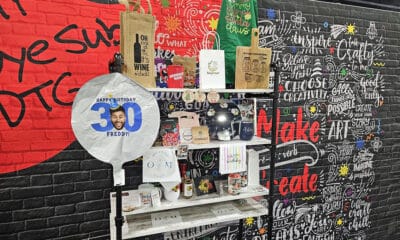Upwards of 24,000 signage, graphics, and specialty print professionals converged on the Las Vegas Convention Center for the final iteration of SGIA Expo, October 18-20. With 612 exhibitors and more than 260,000 square feet of show floor to explore, the depth and reach of the specialty print industry was on full display, shutting down any lingering notions that “print is dead.”

Here are some snippets from the tradeshow floor:
• “The signage and graphics market is strong and it’s evolving. It is defining and becoming disruptive. It’s not just about short runs; it’s about keeping up with digital technology.” –Frank Mallozzi, chief revenue officer, EFI
• “Too many shops are just trying to get by when there are tools available to increase efficiency.” –Michelle Johnson, director of worldwide marketing, SAi
• “It’s amazing what time really means to our customers.” –Lois Catala, marketing communications manager, Agfa Graphics
• “Forty percent of garment decorators say finding new customers is the primary barrier to growth.” –Brett Bowden, founder, Printed Threads
• “Home furnishings have gone through the roof.” –Mike Sanders, director of printable textiles and finishing technology, Top Value Fabrics
Tricks of the Trade
Attendees seeking to expand their industry knowledge (and perhaps a break from walking the expansive show floor) could sit in on 72 educational sessions covering a wide range of topics such as DTG printing, selling strategies and digital marketing, garment decoration, artwork preparation, and beyond. At the “Hiring the Next Generation” session, Donna M. Painter of Millersville University stressed the importance of basing hiring decisions not only on specific hard skills like production workflow or press operation knowledge, but also soft skills like strong work ethic and positive attitude. Seventy-seven percent of print employers want staff with analytical skills, and 83 percent seek employees with social skills, according to Painter.
Advertisement
At the “Women in Print Award Winners Panel Discussion” moderated by Adrienne Palmer, editor-in-chief of sister publication Big Picture magazine, the six winners of Big Picture’s 2018 Women in Print Award spoke about how they entered the wide-format industry, the future of print, hiring and training millennials, and the value of mentorship. “Be willing to let go and reevaluate,” said Allison Kast-Eichenberg, owner of Signarama Chandler, explaining that it’s important to be willing to change for the better instead of being stuck in tradition for the sake of just that – tradition. Though perhaps hard to hear at times, the advice is sound for garment printers – are you running three shifts on a few manual presses, or shying away from DTG technology, or only utilizing plastisol inks because that’s what is best for your business, or because that’s the way it’s always been done? Even in an industry as drenched in history and tradition as screen printing, there’s always room for growth and expansion, whether that’s with automation, new machinery and technology, expansion into new market sectors, or simply a fresh perspective.
 A room full of specialty printing pros joined riCardo Crespo, design and branding expert who has worked for 20th Century Fox and Mattel, at the Garment Decorators Luncheon. Crespo, who will serve as emcee at SGIA’s ThreadX 2019 event (read a recap of the inaugeral event here), echoed Kast-Eichenberg and touted the advantages of bringing in new perspectives and ideas, giving examples of successful, out-of-the-box ad campaigns he had previously executed. “Don’t think like a marketer; think like a storyteller,” Crespo advised. “‘What’s the story?’ is the most important question. Do things that are disruptive but still true to your value proposition.” Crespo asserted that every business has a unique value proposition and identity, and that successful shops find a way to incorporate what they do differently into their brand. Crespo challenged shops to become influencers in the print industry: “You want to be that influencer [that makes] people go, ‘If he or she is doing this, it’s the real deal,’” but not at the expense of authenticity. “Authenticity matters,” he added. “A brand is a promise. You’re trying to show your value.”
A room full of specialty printing pros joined riCardo Crespo, design and branding expert who has worked for 20th Century Fox and Mattel, at the Garment Decorators Luncheon. Crespo, who will serve as emcee at SGIA’s ThreadX 2019 event (read a recap of the inaugeral event here), echoed Kast-Eichenberg and touted the advantages of bringing in new perspectives and ideas, giving examples of successful, out-of-the-box ad campaigns he had previously executed. “Don’t think like a marketer; think like a storyteller,” Crespo advised. “‘What’s the story?’ is the most important question. Do things that are disruptive but still true to your value proposition.” Crespo asserted that every business has a unique value proposition and identity, and that successful shops find a way to incorporate what they do differently into their brand. Crespo challenged shops to become influencers in the print industry: “You want to be that influencer [that makes] people go, ‘If he or she is doing this, it’s the real deal,’” but not at the expense of authenticity. “Authenticity matters,” he added. “A brand is a promise. You’re trying to show your value.”
Read more about the 2018 SGIA Expo or explore the latest edition of Screen Printing.

 Case Studies2 months ago
Case Studies2 months ago
 Art, Ad, or Alchemy2 months ago
Art, Ad, or Alchemy2 months ago
 Andy MacDougall2 months ago
Andy MacDougall2 months ago
 Columns3 weeks ago
Columns3 weeks ago
 Editor's Note2 weeks ago
Editor's Note2 weeks ago
 Marshall Atkinson2 weeks ago
Marshall Atkinson2 weeks ago
 Thomas Trimingham2 months ago
Thomas Trimingham2 months ago
 News & Trends2 months ago
News & Trends2 months ago

 A room full of specialty printing pros joined riCardo Crespo, design and branding expert who has worked for 20th Century Fox and Mattel, at the Garment Decorators Luncheon. Crespo, who will serve as emcee at SGIA’s ThreadX 2019 event (
A room full of specialty printing pros joined riCardo Crespo, design and branding expert who has worked for 20th Century Fox and Mattel, at the Garment Decorators Luncheon. Crespo, who will serve as emcee at SGIA’s ThreadX 2019 event (















